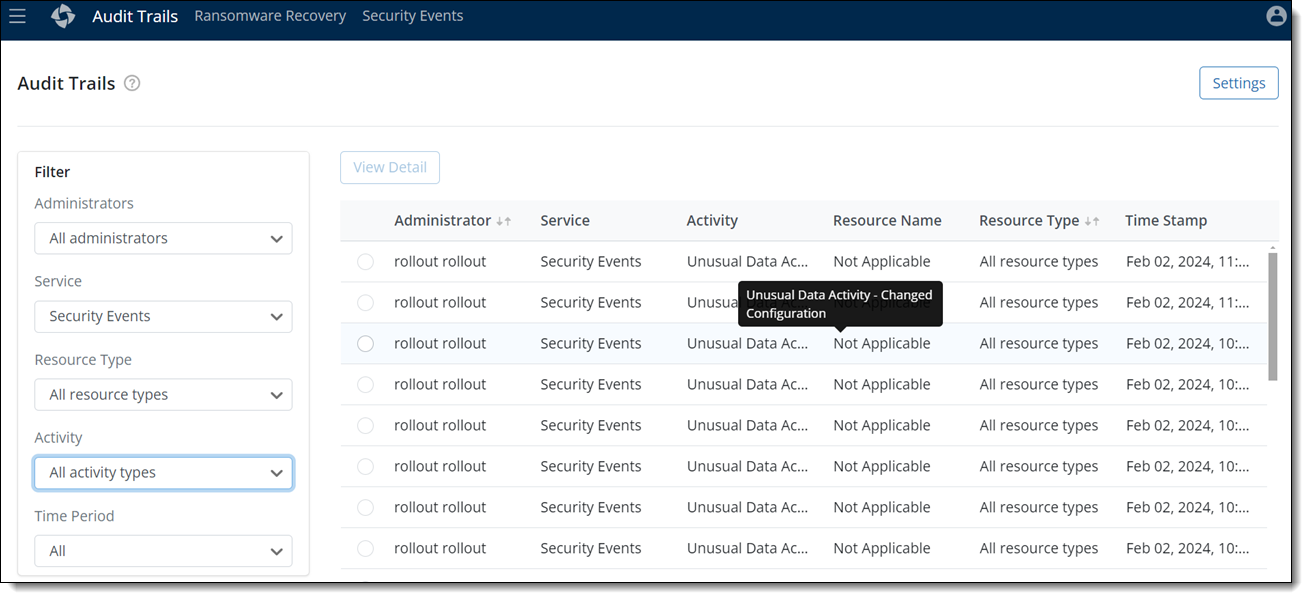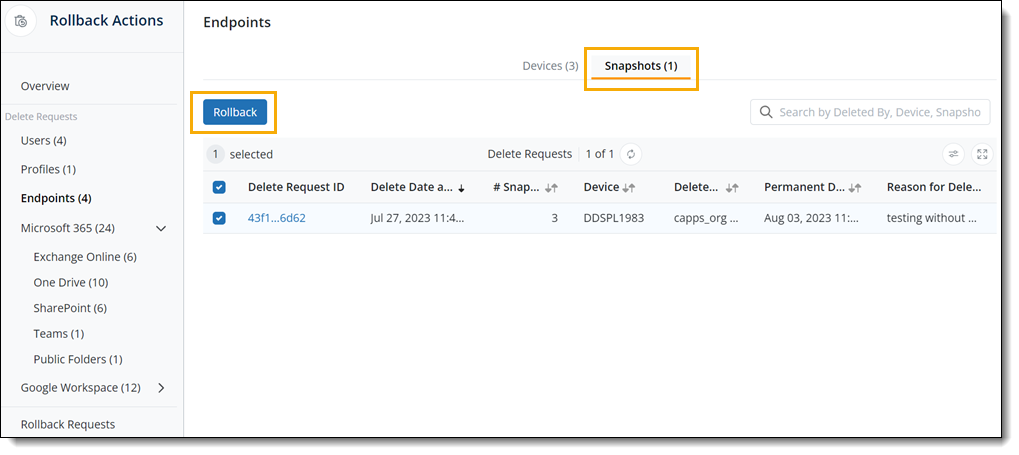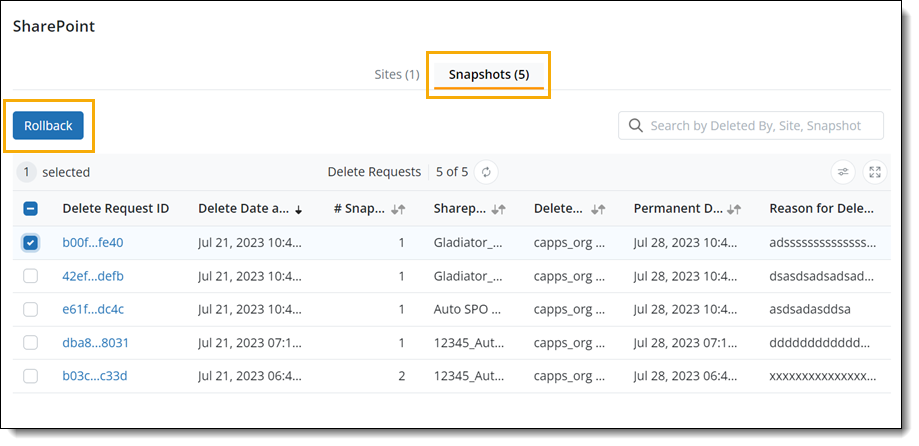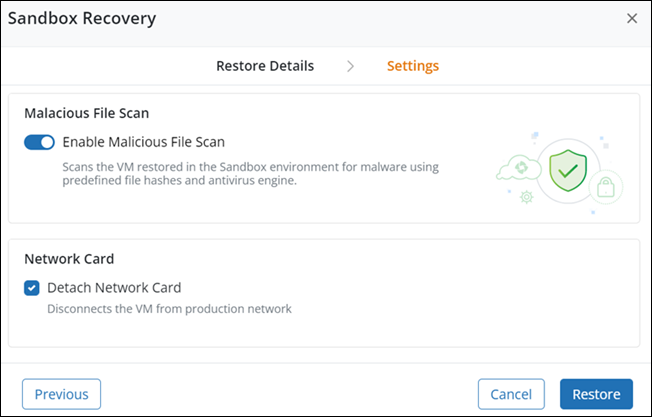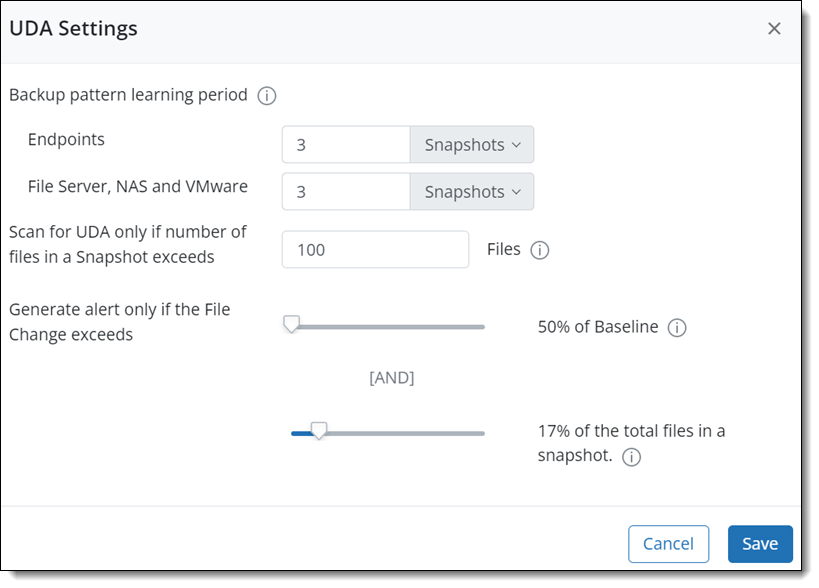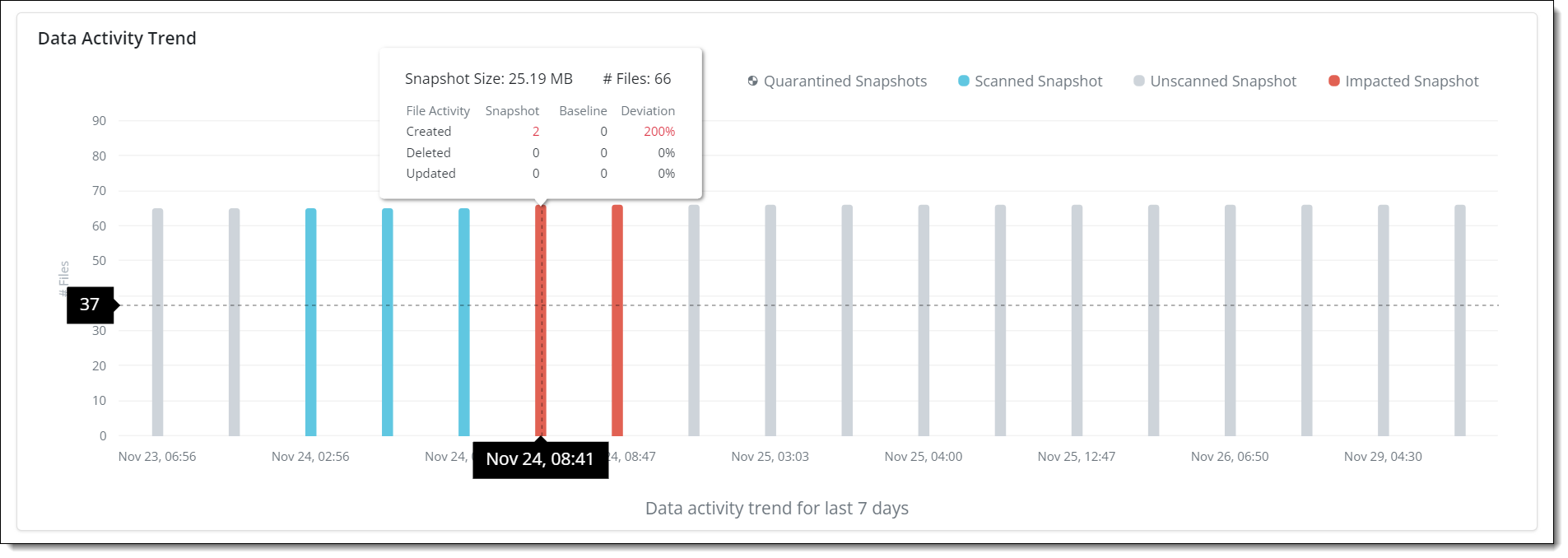Release notes
Our Cloud services are being updated in stages. If you do not see the updates mentioned here yet, they will be available in your region soon. To know more, see Druva Cloud Upgrade Process.
April 1, 2024
Azure VMs
New Feature
View Job Alerts for Azure Virtual Machines
You can now access Alerts generated for your protected Azure virtual machines right from your Enterprise Workloads Dashboard. Alerts are triggered in response to exceptions or potential issues that require your attention. Resolve critical alerts promptly to mitigate any impact on backup or restore operations.
For more information, see Alerts for Azure Virtual Machines.
Customer action required: None.
Gather comprehensive insights on your Azure VM data restores
With the Restore Activity Report, get a comprehensive view of all restore operations on Azure VM backups within your organization. You can now view the status of Azure restore jobs within your environment and subscribe to reports for periodic insights. The report
provides information on each restore job status by resource, enabling administrators to analyze potential issues and initiate corrective actions.
For more information, see Restore Activity Report.
Customer action required: None.
File Server
Enhancement
Updates to File Server agent
This release brings in infrastructural changes to the File Server agent. The upgraded agent includes updates to Druva’s service name, logs location, and configuration file location.
Customer action required:
To redeem benefits of this agent, perform the following actions:
- Upgrade the agent to version 7.0.0-445402.
- Configure your antivirus, and any third-party encryption programs to authorize the latest Druva applications.
- If you have firewall rules in your environment, you must allow Druva and S3 URLs/IPs.
Sort the jobs based on schedule time
With the newly added response parameter, scheduleTime, you can now sort the jobs based on the time the job is created or scheduled. This parameter is added to the following File Server APIs:
- List all jobs
- List all backup jobs
- List all restore jobs
- List all upload logs jobs
For more information, see API reference documentation on the Druva developer portal.
Customer action required: None.
NAS
Enhancement
Updates to the NAS agent
This release brings in infrastructural changes to the NAS agent. The upgraded agent includes updates to Druva’s service name, logs location, and configuration file location.
Customer action required:
To redeem benefits of this agent, perform the following actions:
- Upgrade the agent to version 7.0.0-447428.
- Configure your antivirus, and any third-party encryption programs to authorize the latest Druva applications.
- If you have firewall rules in your environment, you must allow Druva and S3 URLs/IPs
Oracle DTC
Enhancement
Enhance security with a signed SSL certificate
To ensure enhanced security, you can now use your own signed SSL certificates that are verified over a TLS connection. This secures communication between an Enterprise Workloads agent on multiple nodes and between components on the same server. For more information, see Enhance security with a signed SSL certificate.
Customer action required: Upgrade agent to version 7.0.0-445402.
MS SQL Servers
Enhancement
Enhanced security with adoption of TLS1.2
With this update, we are now adopting the TLS1.2 package. Upgrade your agent to avoid facing any vulnerabilities that have been reported against Secure Sockets Layer (SSL) and earlier versions of Transport Layer Security (TLS).
Customer action required:
- Upgrade the agent to version 7.0.0-445402.
- Upgrade to TLS 1.2 for secure communication. For more information, you may refer to TLS 1.2 support for Microsoft SQL Server.
Platform
Enhancement
Enhanced server name consistency across Enterprise Workloads
With this update, servers registered with the Enterprise Workloads agents for multiple workloads now maintain consistent names across all workloads. Any changes made to the server name on one page will be seamlessly propagated to all related pages. This enhancement simplifies server management and ensures coherence across multiple workloads. Currently, this enhancement applies to the following workloads: File Server, MS SQL Server, and NAS.
Customer action required: Upgrade the agent to version 7.0.0-445402.
Note: After upgrading the agent to version 7.0.0-445402, to re-register a device with multiple workloads deployed on it you will need to regenerate activation tokens. Previously generated activation tokens for re-registration will automatically expire.
Known Issues
| Issue | Description |
|---|---|
|
PHN-122903 |
If you upgrade the agent to the version 7.0.0-445402, you get a Warning alert despite a successful upgrade. |
|
PHN-122901 |
If you have File Server, NAS, and Oracle on the same machine with web proxies other than HTTP configured in the config file, then Oracle jobs fail after upgrading to the agent version 7.0.0-445402. Workaround: Configure the web proxy to HTTP. For more information, see Troubleshooting Oracle DTC issues. |
| PHN-122824 | If you have File Server, NAS, and Oracle on the same machine, after upgrading to the agent version 7.0.0-445402, if you change the server name on the primary server, for example, File Server, it does not change name on Oracle server. |
| PHN-125151 | The agent/proxy upgrade for File Server, NAS, VMware, Oracle DTC, and MS SQL Server is not supported if you are using AWS PrivateLink. |
Revision History
The new agents and proxies for Enterprise Workloads will be available for download latest by the next Monday in all the supported AWS regions.
| Platform | Revision | Public Cloud | Gov Cloud |
|---|---|---|---|
|
Windows (File server, MS SQL) |
7.0.0-445402 |
|
|
|
Linux (File server) |
7.0.0-445402 |
||
|
NAS |
7.0.0-447428 |
||
|
VMware Backup Proxy |
7.0.0-445994 |
||
|
Phoenix AWS Proxy |
6.3.5-469889 |
||
|
Hyper-V FLR Proxy |
6.3.5-443722 |
||
|
CloudCache (Windows) |
4.2-402269 |
||
|
CloudCache (Linux) |
R1: 4.2-402269 R3: 6.0.0-387860 |
||
|
Oracle (Phoenix Backup Store) |
6.3.5-470130 |
||
|
Oracle (Direct to Cloud) |
7.0.0-445402 |
||
|
Nutanix AHV |
6.3.5-444902 |
 |
|
|
SAP HANA |
7.0.0-388157 |
 |
March 18, 2024
VMware
Enhancement
Updates to VMware backup proxy
This release brings in infrastructural changes to VMware backup proxy. The upgraded proxy includes updates to Druva’s service name, log locations, and configuration file location.
Customer action required:
To redeem benefits of the enhanced proxy, perform the following actions:
- For the first proxy deployment, use the VMware Proxy Deployer tool version 7.0.0-437835 and later to deploy the latest proxy.
- For existing backup proxies, upgrade to version 7.0.0-438902.
- Configure your antivirus, and any third-party encryption programs to authorize the latest Druva applications.
- If you have firewall rules in your environment, you must allow Druva and S3 URLs/IPs.
Oracle DTC
Enhancement
Support to restore a standalone database to an alternate server using an ASM location
You can now restore your standalone database to an alternate server using an ASM location by passing custom parameters from the console. For more information, see Restore database to an alternate server.
Customer action required: Upgrade Oracle agent to version 6.1.3-466835.
Platform
Enhancement
Telemetry data collection for Enterprise Workloads
We have released an upgraded Enterprise Workloads agent aimed at improving your data protection experience. The enhanced agent collects telemetry data including network, compute, and disk IO metrics from the protected servers and virtual machines. This data is used to optimize Cloud Services performances and provide you with better user experience and enhanced services. This support is made available for VMware workloads with the March 18, 2024 release. The agent support will be extended to other workloads in the subsequent releases.
Customer action required: To leverage the benefits of this agent, you must upgrade your VMware backup proxy to the version released on March 18, 2024.
Known Issues
| Issue | Description |
|---|---|
|
PHN-123110 |
If auto-upgrade for a VMware backup proxy fails and the Druva service cannot connect, then you need to manually re-install the Debian package on the proxy VM and restart the Druva service. |
.
Revision History
The new agents and proxies for Enterprise Workloads will be available for download latest by the next Monday in all the supported AWS regions.
| Platform | Revision | Public Cloud | Gov Cloud |
|---|---|---|---|
|
Windows (File server, MS SQL) |
6.3.5-425213 |
|
|
|
Linux (File server) |
6.3.5-425213 |
||
|
NAS |
6.3.5-440885 |
||
|
VMware Backup Proxy |
7.0.0-438902 |
||
|
Phoenix AWS Proxy |
6.3.5-447189 |
||
|
Hyper-V FLR Proxy |
6.3.5-443722 |
||
|
CloudCache (Windows) |
4.2-402269 |
||
|
CloudCache (Linux) |
R1: 4.2-402269 R3: 6.0.0-387860 |
||
|
Oracle (Phoenix Backup Store) |
6.3.5-425230 |
||
|
Oracle (Direct to Cloud) |
6.1.3-466835 |
||
|
Nutanix AHV |
6.3.5_435405 |
 |
|
|
SAP HANA |
7.0.0-388157 |
 |
February 19, 2024
Oracle DTC
Enhancement
Database upgrade support
Earlier, an upgraded database would be discovered as a new rather than an upgraded one, resulting in the failure of scheduled backups on the existing database. With the new database upgrade support, when the database is upgraded, it is correctly discovered as an upgraded one, and the scheduled backups are executed seamlessly.
Customer action required:
After upgrading the database, perform the following actions:
-
To avoid failure of scheduled backups, either wait for the scheduled auto-discovery or perform the database discovery manually from the Management Console before taking backups.
-
If you have performed a restore from the recovery points created from older versions or if you have performed a major database version upgrade, run the following commands from the SQL prompt:
SQL> startup upgrade;
$ $ORACLE_HOME/perl/bin/perl catctl.pl -n 4 catupgrd.sql
For more information, see Considerations.
Fixed Issues
| Issue | Description |
|---|---|
|
PHN-119279 |
VMware proxy deployment from the Management Console failed with the VMWARE270 error. The VMware proxy is deployed but could not be activated. This issue has been fixed now. |
Revision History
The new agents and proxies for Enterprise Workloads will be available for download latest by the next Monday in all the supported AWS regions.
| Platform | Revision | Public Cloud | Gov Cloud |
|---|---|---|---|
|
Windows (File server, MS SQL) |
6.3.5-425213 |
|
|
|
Linux (File server) |
6.3.5-425213 |
||
|
NAS |
6.3.5-440885 |
||
|
VMware Backup Proxy |
6.3.5-444332 |
||
|
Phoenix AWS Proxy |
6.3.5-447189 |
||
|
Hyper-V FLR Proxy |
6.3.5-443722 |
||
|
CloudCache (Windows) |
4.2-402269 |
||
|
CloudCache (Linux) |
R1: 4.2-402540 R3: 6.0.0-387860 |
||
|
Oracle (Phoenix Backup Store) |
6.3.5-425230 |
||
|
Oracle (Direct to Cloud) |
6.1.3-444192 |
||
|
Nutanix AHV |
6.3.5-395593 |
 |
|
|
SAP HANA |
7.0.0-327748 |
 |
January 22, 2024
NAS
New Feature
Manage backup and restore jobs using NAS APIs
Druva has introduced the following job management APIs:
- On demand backup
- On demand restore
- Cancel backup job
- Cancel restore job
Using these APIs, you can create and cancel backup and restore jobs. For more information, see API reference documentation on the Druva developer portal.
Customer action required: None.
January 15, 2024
NAS
New Feature
List all snapshots using NAS API
You can list all snapshots for a specific backup set using the List all snapshots API. For more information, see API reference documentation on the Druva developer portal.
Customer action required: None.
Enhancement
Deprecation of Smart Scan in NAS
Druva has discontinued support for the Smart Scan feature for NAS workloads. The existing Advanced Smart Scan mechanism will be triggered automatically to perform the file system scan.
Customer action required: Upgrade the agent to version 6.3.1 and later.
Revamping NAS APIs
The following NAS APIs are undergoing some changes and hence, are temporarily removed. The updated APIs will be published in the upcoming release.
- Cancel a job
- On-demand backup
Customer action required: None.
Revision History
The new agents and proxies for Enterprise Workloads will be available for download latest by the next Monday in all the supported AWS regions.
| Platform | Revision | Public Cloud | Gov Cloud |
|---|---|---|---|
|
Windows (File server, MS SQL) |
6.3.5-425213 |
|
|
|
Linux (File server) |
6.3.5-425213 |
||
|
NAS |
6.3.5-425213 |
||
|
VMware Backup Proxy |
6.3.5-425220 |
||
|
Phoenix AWS Proxy |
6.3.5-425214 |
||
|
Hyper-V FLR Proxy |
6.3.4-402306 |
||
|
CloudCache (Windows) |
4.2-402269 |
||
|
CloudCache (Linux) |
R1: 4.2-402540 R3: 6.0.0-387860 |
||
|
Oracle (Phoenix Backup Store) |
6.3.5-425230 |
||
|
Oracle (Direct to Cloud) |
6.1.2-408147 |
||
|
Nutanix AHV |
6.3.5-387093 |
 |
|
|
SAP HANA |
7.0.0-327748 |
 |
January 3, 2024
NAS
Enhancement
Deprecation of Smart Scan in NAS
Starting January 22, 2024, Druva will discontinue support for the Smart Scan feature for NAS workloads. The existing Advanced Smart Scan mechanism will be triggered automatically to perform the file system scan.
Customer action required: You'll need to upgrade your agent to version 6.3.3 to use Advanced Smart Scan.
You must have a valid Security Posture & Observability or Accelerated Ransomware Recovery license to use the Cyber Resilience features.
You can get a view and update on the latest supported and available Security Posture & Observability and Accelerated Ransomware feature from Cyber Resilience Release Notes.
25287



